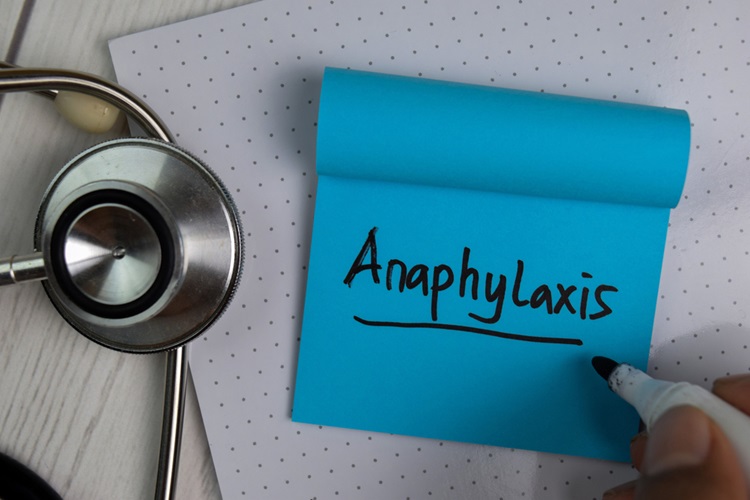Anaphylaxis Symptoms: Warning Signs & Treatment Plan
Anaphylaxis Symptoms: Warning Signs & Treatment Plan

You are enjoying a delightful meal at your favourite restaurant. Suddenly, your throat feels tight, your heart races, and you are struggling to breathe. Panic sets in as you notice a rash spreading across your skin. You are not sure what is happening, but you know it is serious. When you communicate with your doctor, he/she informs you that it might be a symptom of Anaphylaxis.
What is Anaphylaxis?
Anaphylaxis is a severe medical condition that can develop into a life-threatening allergic reaction. It occurs soon after exposure to a triggering substance, such as certain foods, medications, or insect stings.
Anaphylaxis requires immediate medical attention. If the condition worsens and hospitalisation is needed, a health insurance policy can help you manage the financial burden.
What are the common causes of Anaphylaxis?
Anaphylaxis can be caused because of the following reasons —
• You will find various medicines like Penicillin, Aspirin, or NSAIDs that may make your immune system react abnormally. Even small doses can lead to rapid swelling, breathing difficulties, or anaphylaxis if you have a sensitive body.
• If you are exposed to latex in gloves, balloons, or medical equipment, your immune system might misidentify it as harmful. This reaction can trigger severe symptoms like hives and respiratory distress.
• You might develop anaphylaxis after consuming common allergens like peanuts, tree nuts, shellfish, eggs, or dairy.
• A sting from bees, wasps, or fire ants can inject venom into your body, leading to an allergic reaction. If you are highly sensitive, it might escalate into life-threatening anaphylaxis.
What are the Symptoms of Anaphylaxis?
Some common Anaphylaxis symptoms are —
• You might notice hives, redness, or severe itching on your skin. These symptoms appear quickly and indicate your immune system is reacting to an allergen.
• You may notice swelling in areas like your lips, face, or throat. The condition is also called Angioedema and can make breathing or speaking difficult. This symptom occurs as your body releases chemicals during an allergic reaction.
• Anaphylaxis leads to excessive mucus production triggered by an overactive immune response. It narrows or obstructs your airways and makes breathing difficult.
• You might feel your heart racing due to a drop in blood pressure. This compensatory response aims to maintain blood flow to vital organs during the allergic reaction.
• You may experience your skin or lips turning blue, a condition called Cyanosis, due to a lack of oxygen in your blood.
• You may feel a squeezing sensation in your chest, making it hard to take deep breaths.
• You may constantly hear a high-pitched whistling sound while breathing.
• Anaphylaxis can affect your digestive system and can lead to feelings of nausea or episodes of vomiting.
Treatment Plan for Anaphylaxis
• Your doctor may administer an Epinephrine auto-injector immediately to save your life. It relaxes your airways, reduces swelling, and improves blood pressure rapidly.
• Lie flat and elevate your legs to maintain blood flow to vital organs. This prevents shock by stabilising your blood pressure and reducing strain on your heart.
• Your doctor may also administer antihistamines to manage symptoms like hives and itching.
• If you are in shock, IV fluids help stabilise blood pressure and improve circulation. They replenish lost fluids and maintain hydration.
• For severe breathing difficulties, you may need a nebulised beta-agonist like Albuterol Sulfate.
• Immunotherapy is an option if you are highly sensitive to specific allergens.
Conclusion
Anaphylaxis is an acute allergic condition that demands immediate medical attention. Knowing the symptoms and treatments can help save lives. If you are at risk, it is wise to consider a comprehensive healthcare plan to protect against unexpected medical expenses. You can also purchase critical illness insurance if you have an increased risk of such ailments or intend the expand the scope of coverage of your standard healthcare policy. Being prepared can help you manage the financial and health challenges associated with such emergencies.
Frequently Asked Questions
1. What foods commonly trigger anaphylaxis?
Foods like peanuts, shellfish, milk, eggs, and tree nuts are frequent causes of food-related anaphylaxis.
2. What are the respiratory symptoms of anaphylaxis?
These include difficulty breathing, wheezing, coughing, nasal congestion, or swelling in the throat.
3. What is a biphasic anaphylactic reaction?
A biphasic reaction occurs when symptoms reappear hours after the initial anaphylactic response has resolved.
4. How is anaphylaxis different from asthma?
Asthma affects the airways, while anaphylaxis impacts multiple body systems and requires different treatments.
Disclaimer: The above information is for illustrative purposes only. For more details, please refer to the policy wordings and prospectus before concluding the sales.
RELATED ARTICLES
Can You Get a Health Insurance if You Have Food Allergies?
Blood Transfusion Reactions: Risks and Complications
Staying Healthy Through Changing Seasons
Viral Fever – Symptoms, Causes, Prevention and Treatment
Migraine Headaches: Everything You Need to Know










 Health Insurance
Health Insurance  Travel Insurance
Travel Insurance  Car Insurance
Car Insurance  Cyber Insurance
Cyber Insurance  Critical Illness Insurance
Critical Illness Insurance
 Pet Insurance
Pet Insurance
 Bike/Two Wheeler Insurance
Bike/Two Wheeler Insurance  Home Insurance
Home Insurance  Third Party Vehicle Ins.
Third Party Vehicle Ins.  Tractor Insurance
Tractor Insurance  Goods Carrying Vehicle Ins.
Goods Carrying Vehicle Ins.  Passenger Carrying Vehicle Ins.
Passenger Carrying Vehicle Ins.  Compulsory Personal Accident Insurance
Compulsory Personal Accident Insurance  Travel Insurance
Travel Insurance  Rural
Rural 











